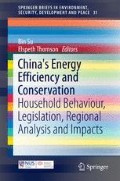Abstract
Along with rapid economic growth over the past decades, China is now facing a dual challenge of improving both energy and emission efficiencies. To trace the trends of energy and pollution efficiencies, this chapter proposes two indices: ecological total-factor energy efficiency (ETFEE), and ecological total-factor pollution efficiency (ETFPE) based on the Russell-based directional distance function. Using regional data from 2001 to 2011, the result shows that the ETFPE is always lower than the ETFEE for any area in China in the same year, indicating that the country is facing a more serious situation with respect to pollution control compared to energy saving.
Dr. Jin-Li Hu, Professor, Institute of Business and Management, National Chiao Tung University, Taiwan; Email: jinlihu@mail.nctu.edu.tw.
Dr. Tzu-Pu Chang, Assistant Professor, Department of Finance, National Yunlin University of Science and Technology, Taiwan.
Access this chapter
Tax calculation will be finalised at checkout
Purchases are for personal use only
References
Asian Development Bank (2013) Toward an Environmentally Sustainable Future: Country Environmental Analysis of the People’s Republic of China. http://www.adb.org/publications/toward-environmentally-sustainable-future-country-environmental-analysis-prc
BP (2011) “China Overtakes USA as Top Energy Consumer as World Demand Grows Strongly, says BP in 60th Year of Global Energy”. http://www.bp.com/en/global/corporate/press/press-releases/china-overtakes-usa-as-top-energyconsumer-as-world-demand-grows-strongly-says-bp-in-60th-year-of-global-energy.html
Chang, T.P. and J.L. Hu (2010) “Total-Factor Energy Productivity Growth, Technical Progress, and Efficiency Change: An Empirical Study of China”. Applied Energy 87: 3262–70
Chang, C.K. and X. Yao (2008) “Air Pollution in Mega Cities in China”. Atmospheric Environment 40: 1–42
Chen, P.C., M.M. Yu, C.C. Chang et al. (2015) “The Enhanced Russell-Based Directional Distance Measure with Undesirable Outputs: Numerical Example Considering CO2 Emissions”. Omega 53: 30–40
Chung, Y.H., R. Färe and S. Grosskopf (1997) “Productivity and Undesirable Outputs: A Directional Distance Function Approach”. Journal of Environmental Management 51: 229–40
Färe, R. and S. Grosskopf (2004) “Modeling Undesirable Factors in Efficiency Evaluation: Comment”. European Journal of Operational Research 157: 242–5
Färe, R. and S. Grosskopf (2010) “Directional Distance Functions and Slacks-Based Measures of Efficiency”. European Journal of Operational Research 200: 320–2
Färe, R., S. Grosskopf, C.A.K. Lovell and C. Pasurka (1989) “Multilateral Productivity Comparisons when Some Outputs are Undesirable: A Nonparametric Approach”. Review of Economics and Statistics 71: 90–8.
Färe, R., S. Grosskopf and F. Hernandez-Sancho (2004) “Environmental Performance: An Index Number Approach”. Resource and Energy Economics 26: 343–52.
Färe, R., S. Grosskopf and D. Tyteca (1996) An Activity Analysis Model of the Environmental Performance of Firms—Application to Fossil-Fuel-Fired Electric Utilities”. Ecological Economics 18: 161–75.
Greenpeace East Asia (2014) “Beijing, Tianjin and Hebei’s Efforts to Reduce Pollution Fall Short”, 16 April. http://www.greenpeace.org/eastasia/news/blog/beijing-tianjin-and-hebeis-efforts-to-reduce-/blog/48907/
Hu, J.L. (2006) “Efficient Air Pollution Abatement for Regions in China”. International Journal of Sustainable Development and World Ecology 13, 4: 327–40.
Hu, J.L., H.J. Sheu and S.F. Lo (2005) “Under the Shadow of Asian Brown Clouds: The Unbalanced Regional Productivities in China and Environmental Concerns”. International Journal of Sustainable Development and World Ecology 12, 4: 429–42.
Hu, J.L. and S.C. Wang (2006) “Total-Factor Energy Efficiency of Regions in China”. Energy Policy 34: 3206–17
Li, L.B. and J.L. Hu (2012) “Ecological Total-Factor Energy Efficiency of Regions in China”. Energy Policy 46: 216–24.
Li, M. and L. Zhang (2014) “Haze in China: Current and Future Challenges”. Environmental Pollution 189: 85–6.
Liu, Y.J. (2011) “Analysis of China’s Current Energy Structure and Trend of Development: Supply and Demand”. Energy Procedia 5: 2593–8.
Meng, X., C. Wang, D. Cao et al. (2013) “Short-Term Effect of Ambient Air Pollution on COPD Mortality in Four Chinese Cities”. Atmospheric Environment 77: 149–54.
Shan, H. (2008) “Reestimating the Capital Stock of China: 1952–2006”. Journal of Quantitative & Technical Economics 10: 17–31. (in Chinese)
Wang, K., B. Lu and Y.M. Wei (2013) “China’s Regional Energy and Environmental Efficiency: A Range-Adjusted Measure Based Analysis”. Applied Energy 112: 1403–15.
Wang, K., Y.M. Wei and X. Zhang (2013) “Energy and Emissions Efficiency Patterns of Chinese Regions: A Multi-Directional Efficiency Analysis”. Applied Energy 104: 105–16.
Wang, K. and Y.M. Wei (2014) “China’s Regional Industrial Energy Efficiency and Carbon Emissions Abatement Costs”. Applied Energy 130: 617–31.
Wang, S. and J. Hao (2012) “Air Quality Management in China: Issues, Challenges, and Options”. Journal of Environmental Sciences 24: 2–13.
Wang, Q., P. Zhou and D. Zhou (2012) “Efficiency Measurement with Carbon Dioxide Emissions: The Case of China”. Applied Energy 90: 161–6.
Wong, E. (2014) “Most Chinese Cities Fail Minimum Air Quality Standards, Study Says”. New Work Times, 27 March. http://www.nytimes.com/2014/03/28/world/asia/most-chinese-cities-fail-pollution-standard-china-says.html
Xing, J., S.X. Wang, S. Chatani et al. (2011) Projections of Air Pollutant Emissions and Its Impacts on Regional Air Quality in China in 2020”. Atmospheric Chemistry and Physics 11: 3119–36.
Zhou, P., B.W. Ang and K.L. Poh (2008) “A Survey of Data Envelopment Analysis in Energy and Environmental Studies”. European Journal of Operational Research 189: 1–18.
Zhu, X. (2012) “Understanding China’s Growth: Past, Present, and Future”. Journal of Economic Perspectives 26, 4: 103–24.
Author information
Authors and Affiliations
Corresponding author
Editor information
Editors and Affiliations
Rights and permissions
Copyright information
© 2016 The Author(s)
About this chapter
Cite this chapter
Hu, JL., Chang, TP. (2016). Energy and Pollution Efficiencies in China’s Regions. In: Su, B., Thomson, E. (eds) China's Energy Efficiency and Conservation. SpringerBriefs in Environment, Security, Development and Peace, vol 31. Springer, Singapore. https://doi.org/10.1007/978-981-10-0928-0_5
Download citation
DOI: https://doi.org/10.1007/978-981-10-0928-0_5
Published:
Publisher Name: Springer, Singapore
Print ISBN: 978-981-10-0927-3
Online ISBN: 978-981-10-0928-0
eBook Packages: Earth and Environmental ScienceEarth and Environmental Science (R0)

